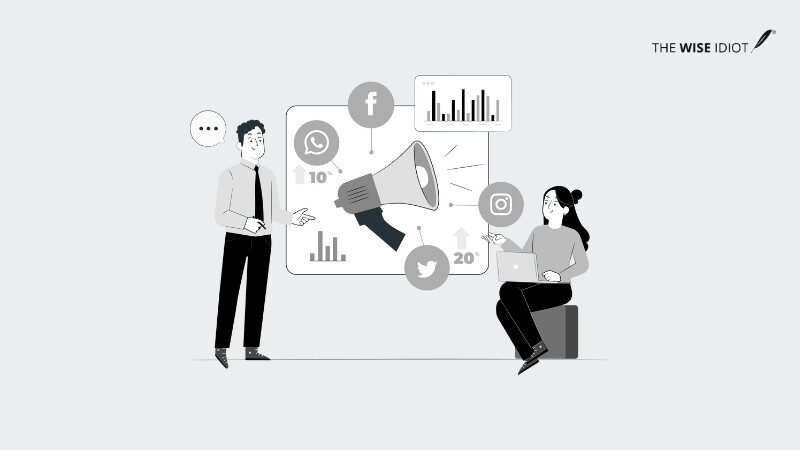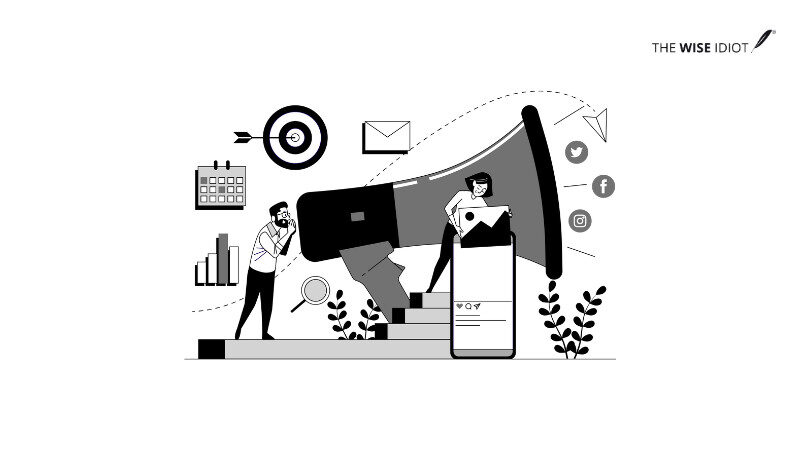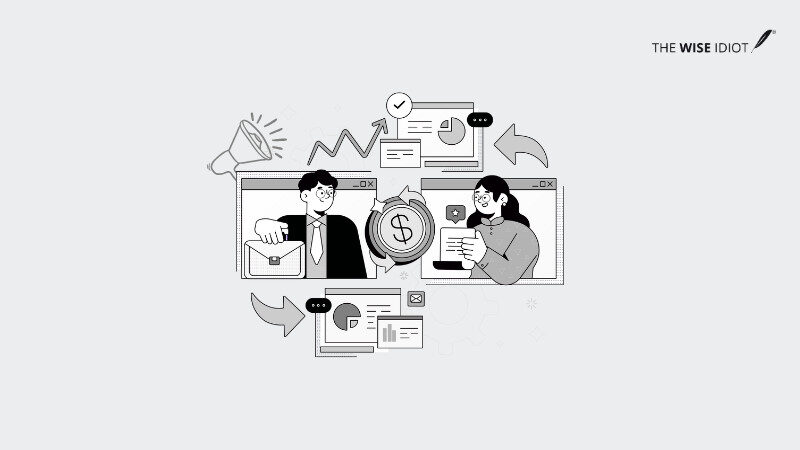B2B social media is a strategic tool for lead gen, sales, and brand trust. Start with clear goals, choose 2–3 platforms where your audience is active, and focus on human, relatable content. Use lo-fi videos, employee advocacy, and paid promotion smartly. Build community, not just followers. Track what matters (like engagement quality and leads), and stay consistent. Let AI help with ideas and scheduling, but keep final content and relationship-building human.
Let’s be honest—B2B social media marketing hasn’t always been the star player in the world of business growth. For years, it sat quietly on the sidelines, seen as a nice-to-have branding tool. Fast forward to today, and it’s not just part of the marketing mix—it is the mix.
If your company is still treating social media as just a branding afterthought, you’re missing out on serious revenue opportunities. Here’s how to build a B2B social strategy that helps move the needle.
What Is B2B Social Media Marketing?
If you’re wondering how to do social media marketing for B2B, it starts with understanding the audience: businesses selling to other businesses, not individuals. But here’s the catch, behind every business decision is a person. That’s why B2B social media today focuses just as much on emotional connection and authenticity as it does on value and logic.
In simple terms, B2B social media marketing means using platforms like LinkedIn, Instagram, and YouTube to reach, engage, and convert business decision-makers. It covers everything from content creation and paid ads to community building and analytics.
Step 1: Start With Strategy, Not Tactics
Before you jump into creating content, you need a solid foundation. Most B2B companies skip this step and wonder why their social efforts feel scattered.
Define Your Goals Using the SMART Framework
Your social media goals should ladder up to actual business outcomes. Here are common B2B social media goals:
Top of funnel: Brand awareness, thought leadership, content reach
Middle of funnel: Lead generation, email signups, demo requests
Bottom of funnel: Deal acceleration, customer advocacy, upselling
Example: “Increase qualified leads from social media by 25% over the next quarter” is better than “get more followers.”
Whether your goal is brand awareness or demo bookings, your B2B social media marketing efforts should be tied to outcomes, not just content output.
Know Your Audience Beyond Demographics
Yes, you’re targeting decision-makers, but they’re also humans who scroll Instagram, laugh at memes, and watch YouTube Shorts. Over 84% of B2B buyers use social media as a key source of information during the purchasing process.
Create detailed buyer personas that include:
- What platforms they use personally vs. professionally
- What type of content they engage with
- What pain points keep them up at night
- How they prefer to consume information (video, text, infographics)
Step 2: Choose Your Platforms Strategically
Knowing how to do social media marketing for B2B starts with picking platforms that align with your audience’s habits and your content strengths.
Not every platform deserves your attention. Focus on 2-3 platforms where your audience actually spends time and you can create quality content consistently.
LinkedIn: Still the B2B Heavyweight
LinkedIn remains the top platform for B2B, but don’t just blast promotional content. The algorithm favors:
- Personal posts from employees over company page posts
- Video content (especially vertical, phone-shot videos)
- Posts that spark genuine conversations in comments
The Surprising Rise of Other Platforms
Platforms like Instagram Reels and YouTube Shorts are becoming increasingly powerful for reach and engagement. They works especially well for:
- Software companies explaining complex features simply
- Behind-the-scenes company culture content
- Educational content that breaks down industry trends
Instagram: Great for visual storytelling and humanizing your brand
YouTube: Perfect for in-depth thought leadership and product demos
Twitter/X: Still valuable for real-time industry conversations and news commentary
Platform Selection Framework
Ask yourself:
- Where does my target audience spend their professional time?
- Where do they go for industry news and insights?
- What type of content can I realistically create well for this platform?
- Do I have the resources to be consistent here?
Step 3: Create Content That Feels Human
The biggest mistake B2B brands make is creating content that sounds like it came from a corporate communications department. Your audience may be CFOs and CMOs, but they’re people first.
The Human-First Content Framework
Tell stories, not just facts. Instead of “Our software increased efficiency by 40%,” try “Here’s how our client went from working weekends to leaving the office at 5 PM.”
Use conversational language. Write like you’re explaining something to a smart colleague, not presenting to a board room.
Show personality. Your brand can have opinions, humor and point of view—just keep it professional and on-brand.
Content Types That Work for B2B
Behind-the-scenes content: Show your team, your office, your process
Educational content: Break down complex topics into digestible insights
Customer stories: Let your clients be the heroes of your content
Industry commentary: Share your take on trends and news
Employee advocacy: Let your team members share their expertise
Step 4: Master the Art of B2B Video
Video is no longer optional for B2B social media. But here’s the counterintuitive part: low-production videos often perform better than expensive, polished ones.
Why Lo-Fi Video Works
Platforms like LinkedIn are seeing more engagement on authentic, phone-shot vertical videos compared to highly produced content. Why?
- They feel more personal and trustworthy
- They’re easier and faster to create
- Audiences are trained to expect this format from social media
- The algorithm favors authentic content
Video Content Ideas for B2B
- Quick tips or insights (30-60 seconds)
- Employee interviews or testimonials
- Product demos or walkthroughs
- Industry trend explanations
- Day-in-the-life content

Video Creation Process
- Plan your key message (write it in one sentence)
- Shoot vertically on your phone
- Keep it under 2 minutes for most platforms
- Add captions for accessibility and silent viewing
- Include a clear call-to-action
Step 5: Build Community, Don’t Just Broadcast
Social media is called “social” for a reason. The brands that succeed focus on building genuine relationships, not just pushing content.
Community-Building Tactics
- Respond to every comment within 24 hours when possible
- Ask questions that encourage meaningful responses
- Share and comment on your audience’s content
- Create content that sparks debate (respectfully)
- Tag relevant people in your posts when appropriate
Measuring Community Health
Look beyond vanity metrics like followers and likes. Track:
- Comment-to-like ratios (higher is better)
- Share rates and saves
- Direct messages and mentions
- Click-through rates to your website
- Actual leads and sales attributed to social
Step 6: Use Paid Promotion Strategically
Organic reach is limited, especially when you’re starting out. A small paid promotion budget can significantly amplify your results.
When to Use Paid Promotion
- Boost your best-performing organic content to reach more people
- Promote gated content like whitepapers or webinars for lead generation
- Target competitor audiences with relevant, helpful content
- Amplify employee advocacy posts that perform well organically
Budget Allocation
Start with 20% of your social media budget on paid promotion. As you see what works, you can adjust. Most B2B companies in India see solid results with a starting spend of ₹40,000 to ₹1.5 lakh per month across platforms like LinkedIn, Instagram, and YouTube.
Step 7: Leverage Employee Advocacy
Your employees’ personal networks are often more extensive and trusted than your company page followers. Employee advocacy can increase your content reach by 8x.
Building an Employee Advocacy Program
- Start with willing participants (don’t force anyone)
- Provide content they can easily share (with suggested captions)
- Offer social media training if needed
- Recognize and reward participation
- Make it genuinely helpful for their personal brands too
Content for Employee Sharing
- Industry insights and trends
- Company milestones and achievements
- Behind-the-scenes content
- Educational resources
- Job postings and company culture content
Step 8: Measure What Matters
Tracking the right metrics helps you prove ROI and improve your strategy over time.
Metrics Framework by Funnel Stage

Tools for Measurement
Free options: Native platform analytics, Google Analytics, UTM tracking
Paid options: Hootsuite, Sprout Social, HubSpot, Buffer
Set up monthly reporting that shows how social media contributes to actual business outcomes, not just engagement vanity metrics.
Step 9: Stay Consistent and Patient
B2B sales cycles are long and social media works best as a long-term relationship-building tool. Consistency beats perfection every time.
Creating a Sustainable Content Schedule
Daily: Engage with comments and mentions
3-4 times per week: Share valuable content
Weekly: Participate in relevant industry conversations
Monthly: Analyze performance and adjust strategy
Content Planning Tips
- Batch create content when possible
- Use content themes for different days (Tip Tuesday, Feature Friday)
- Plan around industry events and seasonal trends
- Keep a running list of content ideas
- Repurpose content across multiple platforms
Common Mistakes to Avoid
Treating social media like a press release distribution channel. Social media is for conversations, not announcements.
Ignoring negative comments or feedback. Address criticism professionally and publicly when appropriate.
Posting the same content across all platforms. Each platform has its own culture and best practices.
Focusing only on your own content. Share and engage with others’ content too.
Giving up too quickly. Social media results take time, give your strategy at least 6 months to show meaningful results.
The Role of AI and Automation
AI tools can help with content ideas, scheduling and basic responses, but don’t let them replace human judgment and creativity.

Getting Started: Your 90-Day Action Plan

Final Thoughts
B2B social media isn’t about going viral or getting thousands of followers. It’s about building genuine relationships with the people who make buying decisions.
Stay consistent, be genuinely helpful, and remember that behind every corporate title is a person who appreciates authentic, valuable content. When you focus on serving your audience instead of selling to them, the business results will follow.
The companies winning at B2B social media today are the ones treating it as a relationship-building tool, not a broadcasting channel. Start there, and you’ll be ahead of most of your competition.
About The Wise Idiot
We’re The Wise Idiot, and yes, that’s really our name. We’re a content marketing agency that’s been helping startups and growing brands tell their stories since 2017.
Here’s what we do: we take the stuff that makes your business special and turn it into content that actually works. Whether that’s writing that doesn’t put people to sleep, websites that make visitors stick around, or social media that gets people talking, we handle it all.
FAQs
Q: What’s the best social platform for B2B marketing?
A: LinkedIn remains the top platform, but don’t ignore Instagram and YouTube depending on your brand voice and audience.
Q: How often should B2B brands post on social media?
A: At least 3–4 times a week to stay visible. But focus on quality and engagement over sheer volume.
Q: Can memes really work for B2B?
A: Absolutely! If done well (and legally), they can increase reach, make your brand relatable and simplify complex ideas.
Q: What type of video content works best?
A: Lo-fi vertical videos (shot on phones) often perform better than polished, high-budget productions, especially on LinkedIn.
Q: Is it okay to use AI for social media content?
A: Use AI for ideas or drafts, but always refine content manually for authenticity and tone.









